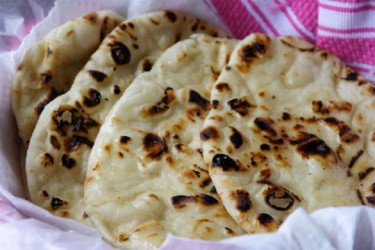Naan is a Middle Eastern and South Asian type of flatbread. The bread is traditionally leavened with yeast and cooked over very high heat. We are more familiar with the Indian-type Naan that is cooked in a tandoor (a type of clay oven).
Restaurant-style, tandoor-cooked Naan is so good! I love the char from the flames licking the top of the bread and how it puffs

up and then lazily deflates into mounds of softness. I like Naan plain but they become something truly special when brushed with ghee, melted butter or some type of herb or garlic flavoured butter. Yum!
We can enjoy Naan at home too, maybe not the same kind that can be had at the restaurants but these are excellent enough for when we have the urge for Naan.
To make it at home you will need a cast iron skillet or a similar kind of heavy bottomed pan. A pot cover large enough to cover the pan and you need to be using a gas stove or some other cooking device that gives flames. A fireside would be perfect!
INGREDIENTS
Yield: 6
● 2 cups all-purpose flour, plus extra for work surface
● 2 teaspoons baking powder
● ½ teaspoon instant yeast
● 1 heaped tablespoon sugar
● ½ teaspoon salt
● 2 tablespoons vegetable shortening, ghee or oil.
● 3 tablespoons whole yogurt
● Lukewarm water or whole milk
● Vegetable oil
● 1 small bowl with tap water
● 1 small pastry brush
DIRECTIONS
1. Line a bowl or basket just as you would when making roti.
2. Mix together the flour, baking powder, yeast, sugar, and salt.
3. Rub in the shortening if using and then add the yogurt, water or milk to make a dough. If you are not using shortening, then add the ghee or oil along with the yogurt and water or milk and knead to make a dough. When the dough comes together, knead for 4 minutes.
4. Rub the bowl and dough with oil, cover and leave to proof in a warm place for about 1 ½ hours or until more than doubled in size.
5. Punch down or press dough to release gas/air and cut dough into 6 equal pieces. Form each piece of dough into a ball. Place on an oiled plate and cover.
6. Heat skillet on medium flame until hot. Meanwhile, lightly flour a work surface and a rolling pin. Roll the dough into a round or oblong or teardrop shape of ¼ inch thickness.
7. Brush the dough (the side facing you) with water and transfer to the heated skillet placing the dough, water-side down. You should hear a sizzle. Cover the pan; reduce the heat to medium low and let cook for 3 – 4 minutes or until puffed up. If you have a glass cover, this makes easy work of seeing when the dough is puffed up.
8. While the first side is cooking, turn on the adjacent burner and set it to low.
9. When the dough is all puffed up and the first side cooked (it should remove easily from the pan, that is an indication that the first side is cooked), remove it from the pan and place it face down (the uncooked side) onto the burner/flames. Let it stay in that position for 10 seconds and then keep moving it around and resting it for 6 – 10 second intervals it is cooked and charred in various places.
10. Remove the Naan and flip it charred-side up and immediately brush with ghee or melted butter. Transfer to lined basket/bowl. Repeat directions 6 – 10 until all the dough is cooked and serve immediately.
NOTES
● Place a piece of wax paper between each cooked Naan, especially if they were brushed with a topping or butter or ghee.
● Toasted whole geera (cumin), Nigella seeds and sesame seeds can be sprinkled onto the Naan immediately after it is brushed with butter or ghee.
● Finely chopped fresh herbs such as basil, cilantro/coriander, parsley and scallions can be mixed with ghee or melted butter and be brushed onto the hot Naan.









